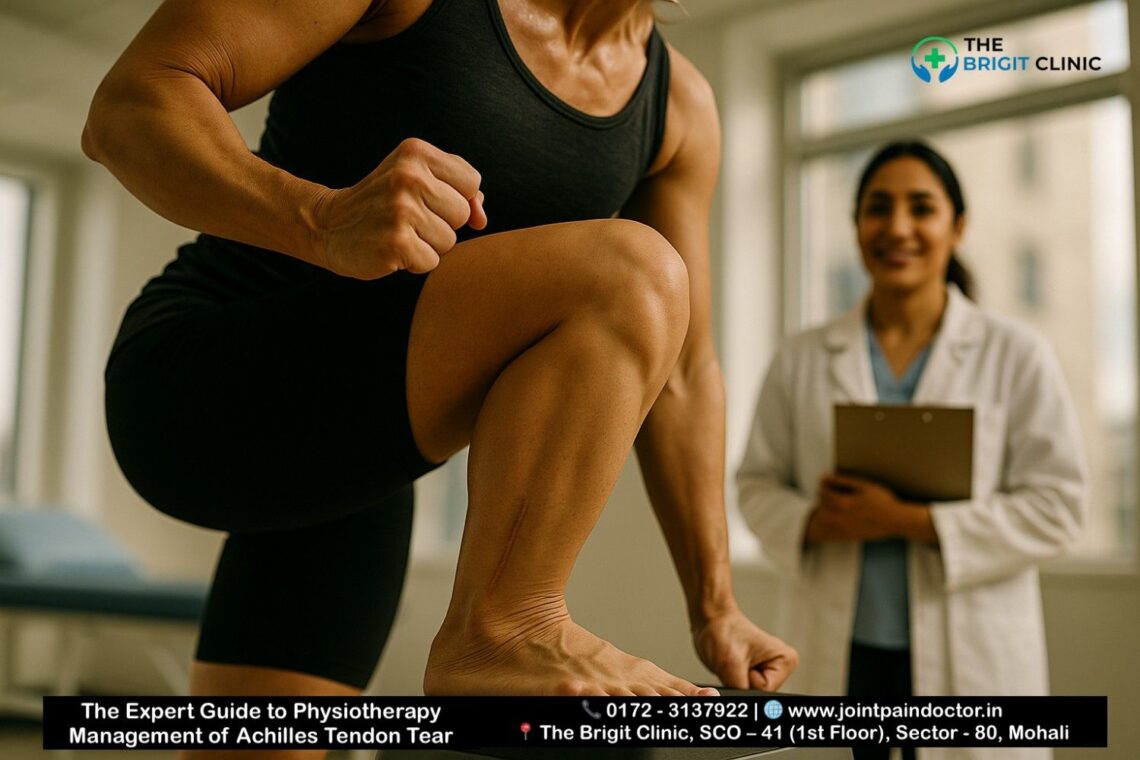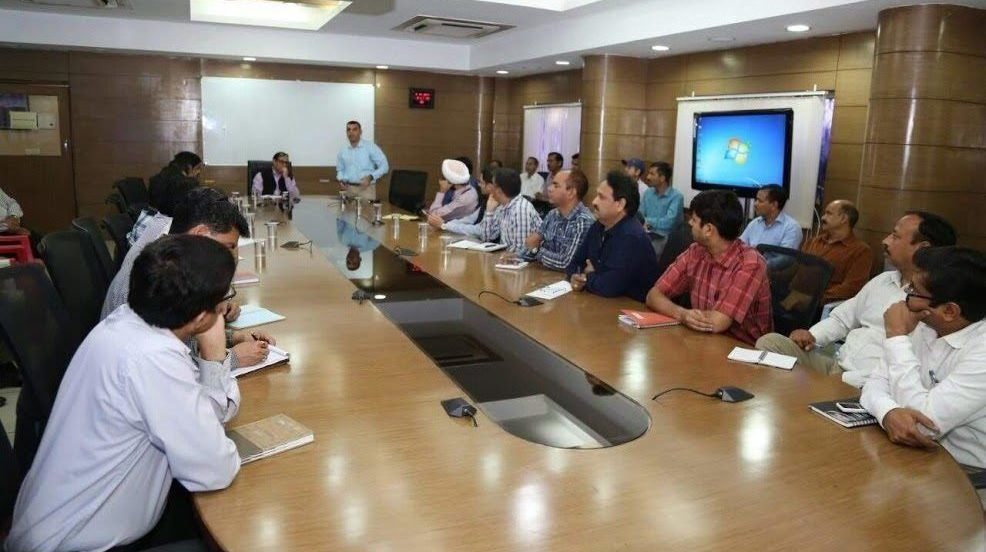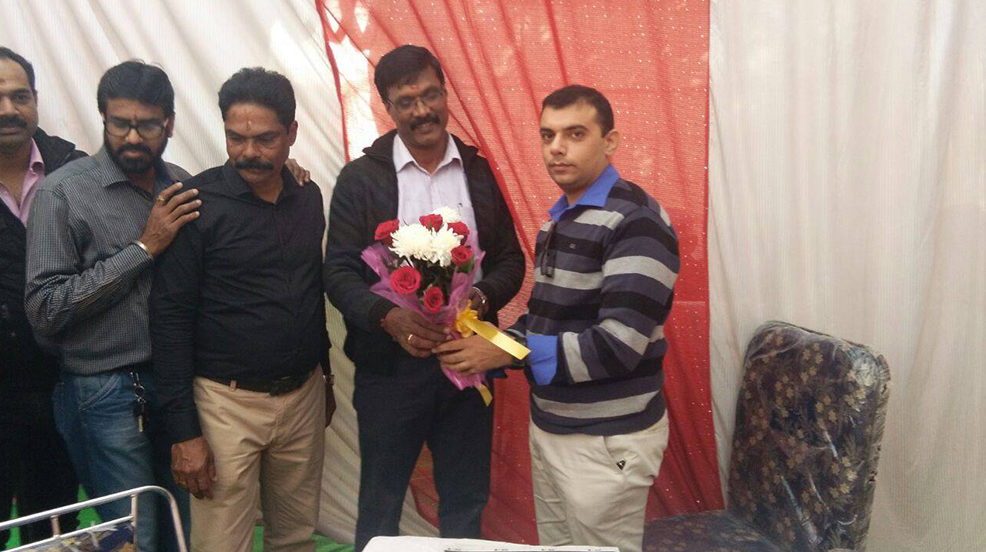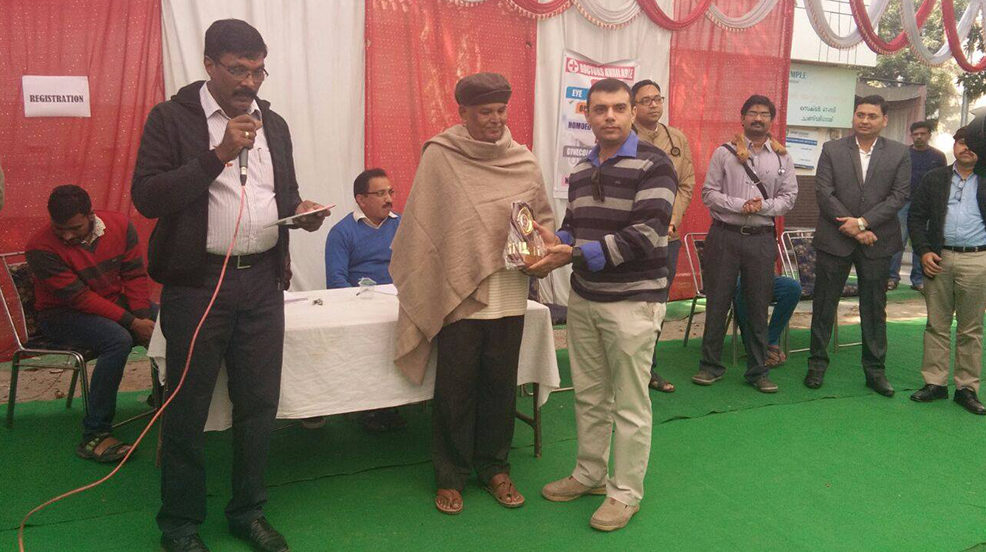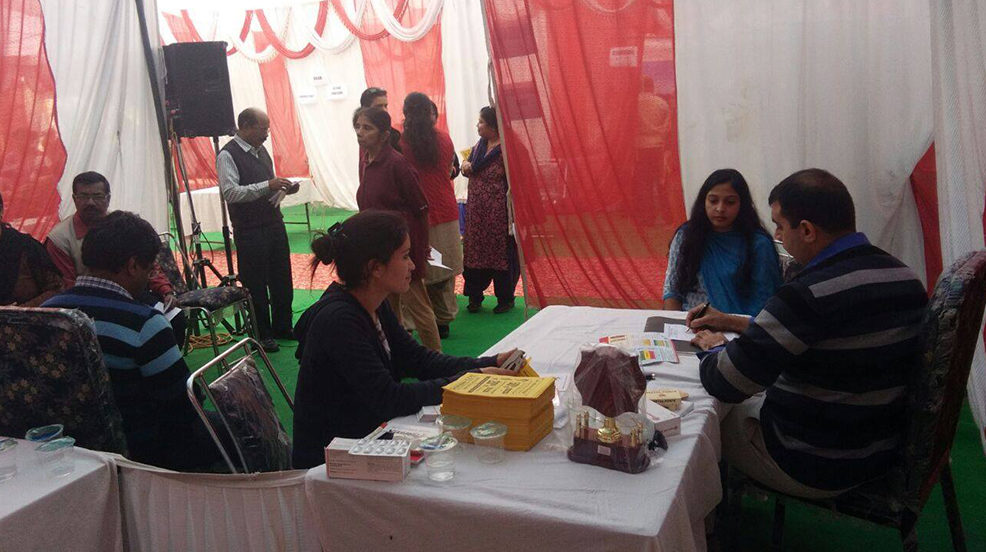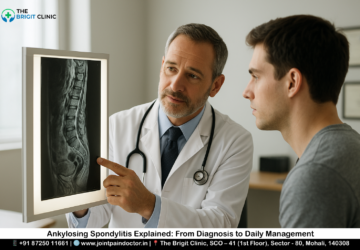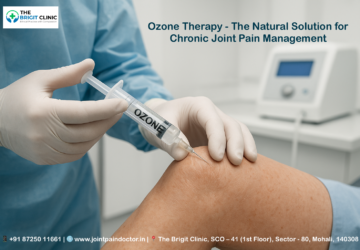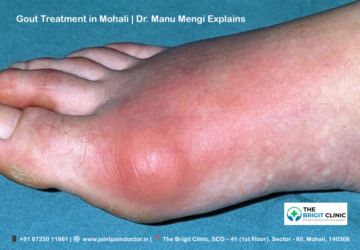Physiotherapy management of Achilles tendon tear is crucial when dealing with the most commonly ruptured tendon in the human body. For patients seeking expert Physiotherapy for Achilles Tear in Mohali, understanding this structured rehabilitation process is the first step toward a successful recovery. This debilitating injury affects 1 in 15,000 people, increasing to 1 in 8,000 in competitive athletes, and represents 6-18% of all sporting injuries. If you’re among the “middle-aged weekend warriors” who account for approximately 70% of these cases, understanding proper rehabilitation is essential for your recovery.
The journey to full healing after an Achilles rupture is undoubtedly challenging. Your tendon requires at least two months to heal, with several additional months needed to regain strength and flexibility. Moreover, the return to sport typically takes between 4-12 months, depending on your activity level and rehabilitation progress. Without proper physiotherapy for Achilles tendon tears, you face a 12.1% probability of rerupture with nonoperative management, highlighting why structured Achilles tendon tear recovery exercises and clear rehabilitation goals after tendon rupture are critical.
Throughout this comprehensive guide, you’ll discover evidence-based protocols for managing an Achilles tendon tear effectively. From early intervention strategies to advanced conditioning for return to sport, we’ll walk you through each phase of rehabilitation with expert guidance. Whether you’re recovering from surgery or managing a conservative treatment approach, this 2025 protocol will equip you with the knowledge to navigate your recovery successfully.
Ready to start your recovery with Mohali's Top Physiotherapy Clinic? Schedule a consultation with our Achilles tendon specialist today.
Setting the Foundation: Early Goals of Physiotherapy
The initial phase following an Achilles tendon tear sets the critical foundation for successful rehabilitation. During these early weeks, your physiotherapy management focuses on three crucial goals that protect your healing tendon while preventing complications that could derail your recovery journey.
Protecting the repair site
Protection of the repair site is paramount during the first 2-3 weeks after an Achilles tendon tear. This phase allows initial tendon healing to begin while minimising the risk of complications. Initially, your foot will be immobilised in a position that promotes optimal healing of the tendon.
For surgical repairs, you’ll typically wear a splint that cannot be removed, as it serves to protect the newly repaired tendon. For non-surgical management, your foot is placed in a rigid cast or functional brace with your ankle positioned in full equinus (approximately 30° of plantarflexion) to maintain contact between the torn tendon ends.
Regarding weight-bearing, protocols vary based on your surgeon’s preference and the type of intervention:
- For traditional approaches, you’ll remain non-weight bearing (NWB) with crutches, a walker, or a wheelchair for at least 6 weeks while wearing your splint or CAM boot
- Some accelerated protocols may allow immediate partial weight-bearing with a CAM boot containing heel lifts
The use of heel lifts serves an important purpose beyond comfort—they can reduce plantar flexor muscle activity by up to 57% during normal gait, consequently decreasing strain on your healing tendon. During this critical protection phase, avoid any activities that stretch or stress the Achilles tendon.
Controlling swelling and pain
Effective management of swelling and pain accelerates healing and improves your comfort during the early rehabilitation phase. The RICE method (Rest, Ice, Compression, Elevation) forms the cornerstone of this approach:
Rest: Stop activities that stress your tendon and switch to low-impact alternatives that don’t strain your Achilles. Your physiotherapist will advise you on appropriate activity modifications.
Ice: Apply ice packs to your tendon for 15-20 minutes every 2 hours during the first 3-4 days after injury or surgery. Always use a waterproof barrier between the ice and your dressing or splint to keep it dry.
Compression: Use an athletic wrap or surgical tape to compress the injured area, which helps reduce swelling. Be careful not to wrap too tightly, as this could impair circulation.
Elevation: Perhaps the most crucial element for swelling control—keep your injured leg elevated above heart level whenever possible. This is particularly important during the first few days post-injury or surgery.
Additionally, your healthcare provider may prescribe pain medications. Use narcotic medications sparingly and try to gradually decrease the amount and frequency over the first two weeks. For milder pain, acetaminophen may be sufficient, although ibuprofen should be avoided as it can delay healing.
Maintaining strength in surrounding joints
While protecting your Achilles tendon, it’s essential to maintain strength in the surrounding joints and muscles to prevent deconditioning and facilitate a faster return to function later. Furthermore, this approach helps minimise the detrimental effects of immobilisation.
During the immediate post-operative phase, you can safely begin:
- Proximal and core strengthening exercises as part of your home exercise program
- Hip and knee muscle exercises to maintain lower extremity strength
- Muscle pump exercises on your uninjured ankle to promote circulation
- Submaximal plantarflexion isometrics in your boot or cast (if approved by your surgeon) to stimulate calf activity while in a protected position
At this point, your physiotherapist will also work to maintain a full range of motion in your hip and knee joints. Throughout this early phase, your therapist will assess your progress using specific criteria, including pain levels (should be less than 5/10) and swelling measurements.
To sum up, the initial goals of physiotherapy after an Achilles tendon tear focus on creating the optimal environment for healing while preventing complications that could prolong your recovery. With proper protection, swelling control, and maintenance of surrounding joint strength, you establish a solid foundation for the subsequent phases of rehabilitation.
Don't let pain and immobility slow you down. Our team at the Best Physio Clinic in Mohali can create a personalised early-stage recovery plan for you. Call 0172-3137922 to book an appointment.
Pain Management Techniques in Achilles Rehab
Effective pain management serves as a cornerstone of successful Achilles tendon rehabilitation, enabling you to progress through therapy milestones while maintaining comfort and function. Understanding the physiological mechanisms behind various pain control techniques helps optimise your recovery journey.
Cryotherapy and its timing
Cold therapy (cryotherapy) remains a fundamental approach for managing pain and inflammation following Achilles tendon tears. This technique works through several mechanisms that directly impact your healing process.
First, cryotherapy significantly reduces local blood flow to your injured Achilles tendon. Research shows that intermittent cold application decreases mid-portion capillary blood flow by an impressive 71%. This reduction helps control the inflammatory cascade that contributes to pain and swelling.
The timing and application method of cryotherapy substantially influence its effectiveness. Notably, intermittent applications of 3×10 minutes produce better clinical outcomes than a single 20-minute session for similar injuries. This protocol maximises the beneficial effects while allowing for tissue reperfusion between applications.
Within just 2 minutes after removing ice, tendon oxygen saturation returns to normal levels. This reperfusion pattern creates a beneficial environment for healing, as repetitive short periods of ischemia (reduced blood flow) followed by reperfusion have been shown to enhance oxygen delivery to tissues.
Beyond pain relief, cryotherapy provides additional physiological benefits:
- It reduces postcapillary venous filling pressures, which improves venous outflow from the tendon
- It decreases production of prostaglandin E2 (PGE2), a key inflammatory mediator in tendon pain
- It lowers COX-2 protein expression, which contributes to the anti-inflammatory effect
For optimal results, apply ice to your Achilles region for 15-20 minutes every 2 hours during the initial 3-4 days post-injury or surgery, gradually decreasing frequency as acute symptoms subside.
Use of TENS or ultrasonics in tendon healing
The factual key points do not provide specific information about TENS or ultrasonic therapy for Achilles tendon healing. Your physiotherapist might incorporate these modalities based on individual assessment and the latest evidence available in clinical practice.
Manual therapy for pain modulation
Manual therapy techniques offer significant pain relief and functional improvements for Achilles tendon injuries through biomechanical, neurophysiological, and psychosocial mechanisms. Though historically underutilised in Achilles rehabilitation, recent evidence supports its effectiveness.
Joint mobilisation and manipulation techniques produce immediate improvements in several measurable outcomes:
- Decreased pain levels during single-leg heel raises
- Increased pressure pain thresholds (PPT), indicating reduced sensitivity
- Improved joint mobility and ankle motion
- Enhanced performance in functional tests like single-leg heel raises
Remarkably, these benefits occur not only when treatment targets the ankle complex but also when applied to remote body sites. This suggests that manual therapy influences central pain processing mechanisms rather than simply addressing local tissue dysfunction.
The neurophysiological effects of joint mobilisation include:
- Decreased nociceptive reflex excitability (reducing pain signals)
- Enhanced conditioned pain modulation (improving your body’s natural pain control)
- Reduction of bilateral hyperalgesia following unilateral treatment
Studies tracking patients with chronic Achilles tendinopathy demonstrate that adding manual therapy to standard eccentric exercise programs leads to significant improvements in self-reported function measured by the Victorian Institute for Sport Assessment questionnaire (VISA-A). These improvements persist at 9-month follow-up assessments, suggesting long-term benefits.
To maximise outcomes, your physiotherapist will likely incorporate joint mobilisation techniques directed at both the ankle complex (talocrural and subtalar joints) and potentially remote sites that influence pain-processing pathways. This comprehensive approach addresses both local mechanical issues and systemic pain mechanisms for optimal recovery.
Struggling with pain from your Achilles injury? Our Achilles Tendon Specialist in Mohali uses advanced pain modulation techniques to accelerate healing. Contact our clinic now.
Restoring Mobility: Range of Motion and Joint Work
Restoring proper mobility represents a critical turning point in your Achilles tendon rehabilitation journey. As you progress beyond the initial protection phase, a carefully structured range of motion work and joint mobilisation techniques become essential for optimal healing without compromising the repair.
Range of motion exercises after Achilles tendon surgery
The introduction of ankle range of motion (ROM) exercises follows a specific timeline based on healing phases. Generally, ankle ROM exercises begin around 4-6 weeks post-surgery, coinciding with the transition to full weight-bearing in a CAM boot.
Initially, ROM work focuses on these key movements:
- Ankle pumps (avoiding dorsiflexion beyond neutral/0 degrees)
- Ankle circles (staying within safe ranges)
- Ankle inversion and eversion
- Seated heel-slides for ankle dorsiflexion (limited to neutral)
Early initiation of active range of motion (AROM) plays a crucial role in facilitating proper collagen fibril formation. Research indicates that early mobilisation specifically helps reduce Achilles tendon elongation and improves clinical outcomes.
From weeks 7-8, you can safely progress to active assisted range of motion (AAROM) and passive range of motion (PROM) techniques as your repair strengthens. Throughout this phase, dorsiflexion limitations gradually ease—starting with restriction to neutral (0 degrees) until approximately week 8, after which you can gently progress dorsiflexion ROM according to tolerance.
Importantly, a sensation of tightness throughout early rehabilitation phases is both expected and often preferred, potentially indicating appropriate tendon elongation rates. In fact, patients rarely complain about their Achilles being “too tight” at long-term follow-up appointments.
Joint mobilisation techniques for ankle & subtalar joints
Joint mobilisation refers to specialised manual therapy techniques used to modulate pain and treat joint dysfunctions that limit the range of motion. For Achilles rehabilitation, assessment and treatment of joint mobility dysfunctions should begin within protected ranges to improve joint mobility without passively stretching the Achilles complex.
Specific joint mobilisation techniques include:
- Talocrural joint mobilisations (anterior-posterior glides) to immediately improve dorsiflexion ROM
- Subtalar joint mobilisations to address compensatory pronation patterns
- Midfoot and metatarsophalangeal (MTP) mobilisations as indicated
The clinical rationale behind these techniques extends beyond mechanical benefits. AP talocrural joint mobilisations have been demonstrated to immediately improve dorsiflexion ROM, which may decrease compensatory subtalar joint pronation as the lower limb advances over the ankle during gait. This reduction in abnormal mechanics decreases abnormal loading through the Achilles tendon.
Furthermore, joint-based mobilisation creates immediate improvements in strength through both peripheral and central mechanisms. Patients with Achilles tendinopathy who receive joint-directed manual therapy as part of a comprehensive treatment plan demonstrate clinically significant improvements in functional measures and pain reduction.
Stretching protocols and precautions
Regarding stretching, a fundamental principle must be emphasised: avoid forceful active and passive range of motion of the Achilles for 10-12 weeks. This precaution prevents excessive strain on the healing tendon fibres.
The stretching protocol typically follows this progression:
- Weeks 4-6: No direct Achilles stretching; focus on toe mobility with great toe dorsiflexion and plantarflexion stretching (not exceeding neutral)
- Weeks 7-8: Continue seated heel-slides for dorsiflexion ROM to tolerance, as dorsiflexion restrictions begin to ease
- After week 8: Progress to standing ankle dorsiflexion stretch on a step
Throughout all phases, carefully monitor your tendon and incision sites for mobility and signs of scar tissue formation. Regular soft tissue treatments, including scar mobilisation (starting 4 weeks post-op) and friction massage, help decrease fibrosis. However, avoid any instrument-assisted soft tissue mobilisation (IASTM) directly on the tendon until at least 16 weeks post-operation.
Equally essential is the stretching of proximal muscle groups. As rehabilitation advances, incorporate gentle stretching of quadriceps, hamstrings, hip flexors, and piriformis as indicated to maintain optimal lower extremity mechanics.
Regaining full ankle mobility is critical. Our Physiotherapists in Mohali are experts in safe and effective joint mobilisation. Visit us to restore your movement.
Building Strength: Progressive Loading Strategies
Progressive strength building represents the foundation of successful Achilles rehabilitation once basic mobility has been restored. This critical phase introduces graduated loading to stimulate tendon healing and restore function to weakened calf muscles. Research consistently demonstrates that carefully structured strengthening protocols improve clinical outcomes and accelerate return to activity.
Isometric calf exercises post rupture
Isometric exercises—contractions where muscle length remains unchanged—serve as the ideal starting point for strengthening after Achilles tendon rupture. These exercises produce minimal tendon stress yet provide significant therapeutic benefits.
Isometric training should begin in the initial stages of rehabilitation to activate calf muscles with a focus on pain control. For optimal results:
- Perform submaximal, non-painful isometric contractions at end-range plantarflexion, which puts the gastrocsoleus complex in a shortened position and minimises elongation stress on the repair
- Start with gentle calf isometrics throughout the day, where you push the ball of your foot into the ground at a tolerable effort level
- Aim for 2-3 sets of 15-45 second holds, performed 1-3 times daily depending on your tolerance
Recent research indicates that isometric plantarflexion holds can provide approximately 50% immediate reduction in Achilles tendon pain during functional loading tests. Interestingly, performing isometrics with the knee extended may produce a 20% larger reduction in symptoms compared to knee-flexed positions, though this difference wasn’t statistically significant.
Unlike patellar tendinopathy, where immediate pain relief follows isometric exercise, Achilles tendinopathy doesn’t consistently show the same immediate analgesic response. Nevertheless, isometrics remain valuable for their ability to promote muscle activation without overstressing the healing tendon.
Theraband exercises for Achilles rehabilitation
Following successful isometric training, resistance band exercises provide the next logical progression in strengthening your Achilles complex. These exercises introduce controlled resistance while maintaining protection of the healing tendon.
To implement Theraband exercises effectively:
- Begin seated with a moderate to heavy resistance band placed around the ball of your foot (not the toes)
- Hold each end with your hands, ensuring appropriate tension by removing any slack from the band
- Straighten your leg while holding the straps, then point your toes as if pushing a gas pedal
- Maintain straight leg position and slow, controlled motion without ankle wobbling
- Perform 10-15 repetitions for 2-3 sets on each leg
As your rehabilitation advances, plantar flexion isometrics can progress to limited range isotonic progressive resisted exercises with blood flow restriction (BFR) as range of motion and contraction tolerance improve. The use of BFR has shown promising results in post-operative Achilles tendon rupture rehabilitation, with one randomised controlled trial demonstrating greater isokinetic strength in the operative calf muscle at 3 months when using BFR compared to standard rehabilitation.
Eccentric and concentric loading phases
The introduction of eccentric and concentric loading represents a pivotal advancement in your strength progression. Eccentric exercise—where the muscle lengthens under tension—has been associated with significant clinical improvements in pain and function for patients with Achilles tendinopathy.
Eccentric loading provides several unique benefits:
- It improves tendon structure, which historically was considered a mechanism for improvement in some persons with Achilles tendinopathy
- It reduces tendon thickness, with studies showing localised decrease in tendon thickness correlated with patient satisfaction
- It potentially increases tendon stiffness, enhancing its response to strain
A standard progressive loading protocol typically follows this pattern:
- Begin with double-leg heel raises standing on flat ground (3 sets of 10-15 repetitions)
- Progress to single-leg seated heel raises (3 sets of 15)
- Advance to two-legged heel raises at the edge of a stair (3 sets of 15)
- Move to one-legged heel raises at the edge of a stair (3 sets of 15)
- Finally, incorporate quick-rebounding heel raises (3 sets of 20)
For eccentric training specifically, the classic Alfredson protocol recommends 3 sets of 15 repetitions twice daily with an extended knee, followed by 3 sets of 15 repetitions twice daily with a flexed knee. Resistance should be added once you can perform these exercises without discomfort.
As strength improves, gravity-assisted devices (such as AlterG) and aquatic therapy can be valuable when developing single-leg strength and the ability to perform heel raises without compensation. By progressively increasing load as the tendon and muscle develop strength and show fewer symptoms, you create the optimal environment for complete rehabilitation and eventual return to full function.
Need a structured strengthening program for your Achilles Rupture Rehab in Mohali? We use evidence-based protocols for maximum results. Get expert guidance today.
Improving Balance and Proprioception
Balance and proprioception training form a vital bridge between basic strength building and functional movement in your Achilles rehabilitation journey. Given that proprioception provides essential information needed to modify ankle position during complex motor tasks, restoring this neural sense becomes indispensable for preventing future injuries.
Ankle proprioception training
Proprioception—the neural process by which your body takes in sensory input from the environment and integrates that information to produce appropriate motor responses—dramatically affects recovery outcomes. After Achilles injury, this neural feedback system often becomes compromised, making targeted retraining essential.
For optimal rehabilitation, physiotherapists typically incorporate ankle proprioceptive neuromuscular facilitation (PNF) techniques using the contract-relax approach. Research indicates these techniques should be performed with ten repetitions for one set, twice daily. Early enhancements in joint proprioception through these interventions aid in earlier mobilisation, creating a positive cycle of improvement.
The most compelling evidence supports beginning proprioception training once you’ve established basic weight-bearing tolerance. Physiotherapists design specific exercises based on orthopaedic loading recommendations coupled with your clinical condition. One study demonstrated that athletes with functional ankle instability showed significant improvements in eversion, plantarflexion, dorsiflexion, and inversion joint position sense following eight weeks of ankle proprioceptive exercises.
Balance & stability training for Achilles injury
Effective balance training encompasses exercises that challenge your neuromuscular system’s ability to maintain stability. Studies examining proprioceptive training’s prophylactic effectiveness found a significant 35% reduction in ankle sprain risk for individuals who completed such programs.
Common balance exercises include:
- Double limb standing balance on uneven surfaces like wobble boards
- Single-leg balance exercises, first on flat surfaces, then progressing to unstable surfaces
- Balance training with perturbation challenges—where balance is deliberately disrupted
- BAPS (Biomechanical Ankle Platform System) board exercises in the standing position
- Walking on mini trampolines
First thing to remember is that balance training should start with simple, supported exercises before advancing to more challenging variations. As per research findings, compliance with rehabilitation protocols substantially affects outcomes—studies showed noncompliance levels between 10-40%, which aligned with real-world clinical practice. Hence, exercises should be engaging yet manageable to ensure adherence.
Progression from bilateral to single-leg stance
The systematic progression from bilateral to unilateral stance represents a crucial advancement in your rehabilitation. Initially, you’ll begin with double-leg balance activities on stable surfaces, henceforth progressing to more challenging environments and positions.
A structured progression typically follows this pattern:
- Double leg balance on firm ground with eyes open
- Double leg balance on air pads or balance boards (aiming for 10-second holds)
- Single leg stance with eyes open (10-second holds)
- Single leg stance while throwing and catching a ball against a wall
- Single leg stance with eyes closed (10-second holds)
- Single leg balance on air pads or balance boards
- Advanced training on BOSU balls or trampolines
Throughout this progression, focus on proper ankle mechanics rather than compensating through hip movements. For patients transitioning out of the protective boot phase, single-leg balance exercises help normalise walking patterns and eliminate limping. Practising for 3 sets of 60 seconds can significantly improve stability.
Studies reveal that implementing balance and proprioception training can prevent one ankle sprain for every 17 patients who complete the protocol, regardless of prior injury history. Above all, those with previous Achilles injuries show even greater benefits, with a 36% reduction in reinjury risk.
Prevent future injuries with our specialised balance training programs at our Physiotherapy Clinic in Mohali. Book your assessment now.
Gait Training and Functional Movement Re-education
Regaining natural walking patterns stands as a crucial milestone in your Achilles tendon rehabilitation. Studies reveal that gait abnormalities often persist for more than a year after surgery, including increased dorsiflexion range of motion, co-activation of lower leg muscles, and decreased step length. These lingering issues directly impact your overall quality of life and physical activity levels.
Gait training after Achilles tear
Following an Achilles rupture, your tendon typically elongates during healing, causing increased dorsiflexion during walking. Research shows this anatomical change forces your calf muscles to work harder—EMG studies demonstrate significantly increased muscle activity in the triceps surae on the affected side. This heightened muscle activation represents your body’s attempt to compensate for increased tendon slack during walking.
Your rehabilitation should follow a structured progression for weight bearing:
- Weeks 0-2: Non-weight bearing in protective splint
- Weeks 3-6: Begin partial progressive weight bearing with an assistive device and boot with three heel wedges
- Weeks 6-7: Full weight bearing in boot with gradually decreasing heel wedges
- Weeks 8-12: Gait training to wean off assistive devices while normalising gait pattern
Interestingly, aquatic therapy and unweighted treadmills prove especially beneficial for restoring proper mechanics simultaneously with gradual weight-bearing progression.
Correcting compensatory patterns
Patients with Achilles injuries typically develop specific compensatory patterns to reduce tendon loading. Research identifies common adaptations, including reduced ankle dorsiflexion and knee flexion during heel drop exercises. Another study revealed that even after 4.5 years, patients still exhibit 13.4% larger peak dorsiflexion in stance on the injured leg.
As a physiotherapist, identifying these compensations through careful observation remains essential. Look for prolonged stance phase and avoidance of push-off in terminal stance. In tandem with visual assessment, techniques like in-line tandem walking effectively highlight and correct remaining asymmetries.
Use of assistive devices and weaning off
Initially, crutches or a walker with strict non-weight bearing protect your surgical repair. The transition away from these devices follows a methodical approach coordinated with your weight-bearing status. By week 4, you’ll typically begin partial progressive weight bearing on crutches in an Achilles boot with three wedges.
An often-overlooked tool—the “Even Up” shoe leveller for your uninvolved foot—prevents secondary musculoskeletal problems by equalising leg lengths. Correspondingly, gait training with assistive devices should emphasise that your weight-bearing progression aligns with ideal mechanics, as poor patterns lead to joint dysfunction and adverse muscle tone.
By week 8, you should achieve full weight bearing in the boot without crutches, demonstrating a normalised gait pattern. Subsequently, progress to walking in athletic shoes with a heel lift around weeks 8-10 under clinical supervision before community ambulation.
Walk with confidence again. Our Best Physiotherapist for Achilles Tear in Mohali will correct your gait and eliminate limping. Start your functional re-education.
Advanced Conditioning and Return to Sport
The final phase of Achilles tendon rehabilitation focuses on advanced conditioning and sport reintegration. Despite successful surgical repair, studies reveal that 20-25% of patients cannot return to sport after an Achilles tendon tear, making this transition particularly challenging yet crucial for athletes and active individuals.
Return to activity guidelines after Achilles repair
The journey back to sports typically begins 6+ months post-surgery, with return to play ranging from 61-100% in elite athletes. Before advancing to sport-specific activities, you must meet several objective criteria:
- Standing heel rise test >90% compared to the uninjured side
- Lower extremity functional tests ≥90% compared to the contralateral side
- Completion of both phases of a return-to-running program without pain/swelling
- No major deficits with core and single-leg squat testing
Research indicates plantar flexion strength deficits often persist between 10-30% even after one year post-operative. Due to this, a target of >90% Limb Symmetry Index (LSI) for strength assessment is recommended before sport reintegration.
Sport-specific drills and plyometrics
Plyometric training becomes essential for developing the stretch-shortening cycle of your tendons—a key requirement for running and jumping activities. Remarkably, research shows jumping exercises can create forces exceeding seven times your bodyweight through the Achilles tendon.
Your plyometric progression should follow this sequence:
- Double-leg hops with slightly bent knees
- Double-leg hops with stiff knees (isolating Achilles work)
- Single-leg hops with gradual intensity increases
- Sport-specific movement patterns
For optimal tendon adaptation, limit plyometric sessions to 1-2 weekly with adequate recovery between strength training days. Sport-specific conditioning typically initiates around 18-20 weeks post-surgery, with formal testing including the Vail Sport Test, agility T-test, and three-cone drill to assess readiness.
Psychological readiness and functional testing
In essence, psychological factors significantly impact recovery during rehabilitation and return to sport. Fear of reinjury emerges as the primary barrier, reported by 41.30% of patients who didn’t return to their previous activity levels.
The Ankle Ligament Reconstruction-Return to Sport Injury (ALR-RSI) score provides a valid assessment of psychological readiness. This tool demonstrates strong correlation with functional outcomes and excellent discriminant validity—patients who returned to sport scored significantly higher (83.2) than those who didn’t (60.7).
Before full clearance, comprehensive functional testing should include:
- Sport-specific movement assessments
- Reactive strength index testing for explosive sports
- Single-leg hop tests with >95% LSI compared to the uninjured leg
Ready to return to your sport? Our Achilles Tendon Tear Treatment Mohali program includes advanced sport-specific conditioning. Achieve your comeback with us.
Home Exercise Program and Long-Term Maintenance
Mastering long-term self-management marks the final frontier in your Achilles tendon tear rehabilitation. Even after formal physiotherapy concludes, your commitment to consistent home exercises and vigilant monitoring determines the ultimate success of your recovery journey.
Home exercises program for the Achilles tendon
A well-structured home exercise program remains fundamental to your continued progress. Most patients can return to normal activity in 4-6 months with proper home exercise adherence. Your program should evolve as you heal:
Early Phase (Weeks 2-4):
- Seated calf stretch with knee straight: Hold 15-30 seconds, repeat 2-4 times
- Passive toe stretch: Gently bend your toe forward and backwards, holding each position for 15 seconds
- Submaximal plantarflexion isometrics in a protected position
Intermediate Phase:
- Calf stretch on a step: Lower heels below step edge, hold 15-30 seconds
- Heel raises: Progress from seated to standing exercises
Advanced Phase:
- Single-leg heel raises: 3 sets of 8-12 repetitions
- Lower calf strengthener: 30 repetitions with knees slightly bent
For instance, the calf stretch involves standing facing a wall, placing one leg behind with the heel down, then gently leaning forward until you feel a stretch. Exercise frequency should be consistent—aim for daily stretching and strengthening sessions to maximise recovery outcomes.
Monitoring for signs of overuse or re-rupture
In parallel with your exercise program, vigilant monitoring for warning signs prevents setbacks. After healing, you face a greater risk of re-injuring your Achilles tendon. Key warning signs include:
- Sudden sharp pain in the tendon area
- New swelling or redness
- Inability to rise onto tiptoes
- Altered gait mechanics
- Pain that persists more than 24 hours after activity
The contralateral limb likewise requires attention—studies show a higher incidence of contralateral Achilles rupture following initial ATR compared to general population rates. Ultimately, maintaining awareness of both tendons safeguards your long-term function.
Patient education and lifestyle modifications
Beyond exercises, specific lifestyle adjustments support lasting recovery. Essential modifications include:
- Footwear selection: Avoid high-heeled shoes, which increase tendon stress
- Activity preparation: Always stretch before exercise and incorporate a proper warm-up
- Sport considerations: Consult your provider before returning to sports involving rapid starts/stops like tennis, racquetball or basketball
- Progressive loading: Increase exercise intensity gradually—never more than 10% weekly
As you continue rehabilitation, swimming, cycling, jogging, or walking effectively enhances muscle strength and range of motion. Gradually introducing low-impact activities before returning to high-impact exercises protects your tendon for the initial 6 months post-injury. Following these protocols not only prevents re-rupture but also creates optimal conditions for lifelong tendon health.
Get a personalised home exercise program from the Best Physio Clinic in Mohali. We ensure you recover fully and stay healthy. Contact us for long-term support.
Conclusion
Rehabilitation after an Achilles tendon tear undoubtedly represents a lengthy process requiring patience, dedication, and expert guidance. Throughout this comprehensive guide, you’ve learned the essential components of effective physiotherapy management—from initial protection strategies to advanced sport-specific training. Accordingly, your recovery journey progresses through distinct phases, each building upon the previous while addressing specific rehabilitation goals.
The early phase focuses on protecting your healing tendon while managing pain and swelling. Subsequently, careful mobility work prepares your ankle for progressive loading, which stimulates proper tendon healing. Balance training and gait re-education, then restore normal movement patterns before sport-specific exercises, prepare you for return to activity.
Despite following optimal protocols, most patients still experience some strength deficits even a year after rupture. Nevertheless, these deficits rarely impact daily function when properly managed. Your commitment to home exercises after formal physiotherapy concludes significantly determines your long-term outcomes.
Many patients wonder about their ultimate recovery potential. Research shows that while complete recovery takes time, most individuals return to previous activities, albeit sometimes at modified levels. Your dedication to rehabilitation directly correlates with recovery quality—those who adhere strictly to protocols generally achieve better functional outcomes than those who don’t.
Remember that healing continues well beyond the initial repair phase. Therefore, maintaining vigilance for warning signs while gradually increasing activity levels safeguards your recovery investment. Though challenging at times, proper physiotherapy management after an Achilles tendon tear provides your best path toward restored function and return to the activities you enjoy.
Your journey to recovery starts with a single step. Trust Mohali's Top Physiotherapy team to guide you every step of the way. Schedule your comprehensive assessment at our clinic today.
Key Takeaways
This comprehensive guide reveals evidence-based strategies for successful Achilles tendon tear rehabilitation, from initial injury through complete recovery and return to sport.
• Early protection is critical: Maintain non-weight bearing for 6+ weeks with proper immobilisation to prevent re-rupture (12.1% risk without proper care)
• Progressive loading accelerates healing: Begin with isometric exercises, advance to eccentric training using the Alfredson protocol (3 sets of 15 reps twice daily)
• Balance training prevents future injury: Proprioception exercises reduce ankle sprain risk by 35% and reinjury risk by 36% in previously injured patients
• Strength deficits persist long-term: Expect 10-30% plantar flexion weakness even one year post-surgery; achieve >90% limb symmetry before sport return
• Home exercise adherence determines success: Daily stretching and strengthening exercises are essential for a 4-6 month recovery timeline and long-term tendon health
• Psychological readiness matters equally: Fear of reinjury affects 41% of patients who don’t return to sport; address mental barriers alongside physical rehabilitation
Recovery typically takes 4-12 months, depending on activity level, with formal physiotherapy progressing through distinct phases of protection, mobility restoration, strength building, and sport-specific conditioning. Success depends on strict protocol adherence and gradual activity progression.
FAQs
Q1. How long does physical therapy typically last for an Achilles tendon tear?
A1. Physical therapy for an Achilles tendon tear usually lasts 4-6 months, but can extend up to 12 months depending on the severity of the injury and the individual’s activity level. The rehabilitation process progresses through distinct phases, from initial protection to advanced sport-specific training.
Q2. What is the Alfredson protocol for Achilles tendon rehabilitation?
A2. The Alfredson protocol is a specific eccentric exercise program for Achilles tendon rehabilitation. It involves performing 3 sets of 15 repetitions twice daily with an extended knee, followed by 3 sets of 15 repetitions twice daily with a flexed knee. This protocol has shown significant clinical improvements in pain and function for patients with Achilles tendinopathy.
Q3. When can I start weight-bearing after an Achilles tendon tear?
A3. Weight-bearing typically follows a structured progression. You’ll usually remain non-weight bearing for the first 2-3 weeks, then begin partial progressive weight bearing around weeks 3-6 with an assistive device and protective boot. Full weight bearing in a boot often starts around 6-7 weeks post-injury, with gradual weaning off assistive devices in the following weeks.
Q4. How effective is balance training in preventing future Achilles injuries?
A4. Balance and proprioception training are highly effective in preventing future injuries. Research shows that implementing such training can reduce ankle sprain risk by 35% in general and decrease reinjury risk by 36% in previously injured patients. These exercises are crucial for restoring proper neuromuscular control and stability.
Q5. What are the key indicators that I’m ready to return to sports after an Achilles tear?
A5. Before returning to sports, you should meet several criteria: achieve >90% strength in the affected leg compared to the uninjured side, complete a return-to-running program without pain or swelling, demonstrate no major deficits in core and single-leg squat testing, and score well on psychological readiness assessments. Additionally, sport-specific movement assessments and functional tests should show comparable performance to the uninjured leg.
About the Physiotherapist – Dr. Aayushi
Dr. Aayushi is a renowned physiotherapist and the driving force behind one of Mohali’s leading physiotherapy clinics. With extensive experience and a deep commitment to patient care, she specialises in the management of complex musculoskeletal conditions, including Achilles tendon tears. Dr. Aayushi believes in a holistic and evidence-based approach to rehabilitation, combining advanced manual therapy techniques with tailored exercise programs to ensure optimal outcomes for every patient. Her expertise in Achilles Tendon Tear Treatment in Mohali has helped numerous athletes and active individuals successfully return to their desired levels of activity, making her a trusted name for Physiotherapy in Mohali.
Your Journey to Recovery Starts Here. Let’s Take the First Step Together.
Recovering from an Achilles tear is a marathon, not a sprint. It requires expert guidance, unwavering dedication, and a personalised plan that adapts to your unique healing process. You don’t have to navigate this challenging path alone.
At our Mohali clinic, we don’t just treat injuries; we rebuild confidence and restore function. Under the expert care of Dr. Aayushi, you will receive a comprehensive treatment program based on the latest evidence, designed to get you back to the life and sports you love, stronger and safer than before.
